“Crossroads of Old and New in the ‘Land of Enchantment'”
by Vincent Veerbeek
From its origins as a Spanish colonial town to its popularity as a stop along Route 66, the city of Albuquerque in New Mexico might be best known today as the setting for the television show Breaking Bad and the home of the largest balloon festival in the world. My time as a Fulbright visiting scholar at the University of New Mexico (UNM) gave me an opportunity to live in this city and study a side of its history that is less well known but no less significant: the century during which it was home to a government boarding school for Native American children.
With the support of a grant that I received from the Fulbright Commission of the Netherlands, I was able to spend half a year in Albuquerque from September 2023 to March 2024. My time in the United States was part of my PhD research at the University of Helsinki, where I am working on a dissertation about the history of music education and marching bands as a part of efforts by the American government to assimilate Native Americans in boarding schools at the turn of the twentieth century. One of those institutions was the Albuquerque Indian School, which primarily targeted children from the nearby Pueblo communities, as well as Apache and Navajo children from elsewhere in the region.
The primary purpose of my time in New Mexico was to do archival work at the Center for Southwest Research, an archive within the UNM library, which has several collections related to the history of the government schools in the American Southwest and elsewhere. After previously spending some time at the United States National Archives in Washington, D.C., on a short research trip earlier in my PhD, and exploring source material that is available online, it was exciting to be at a single archive for an extended period of time and really delve into its collections. The Center for Southwest Research is a fairly small archive, and it felt good to do my work in a more informal atmosphere. This way, I also got to know the archivists, who were a great help in locating sources as well as making me feel at home in Albuquerque.
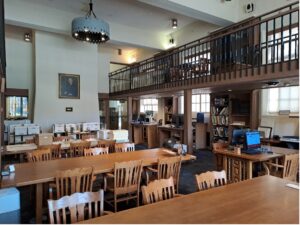
The Anderson Reading Room at the Center for Southwest Research
Among the collections I consulted during my research semester were several that were particularly impressive. Those included the papers of the first superintendent of Albuquerque Indian School, Richard Bryan, who created several scrapbooks with clippings of newspaper articles about the early days of the school that gave insight into the lives of Native American students during the 1880s. A very different type of source was a series of transcripts from interviews that researchers did during the 1980s with former students of the Santa Fe Indian School, a similar institution to the school in Albuquerque. These oral histories provide a Native American perspective on the school, and some of the people interviewed remembered the school band and how it shaped daily life. Finally, I was able to work with microfilm collections and look through newspapers from different government boarding schools, which are a valuable resource for learning about the history of these schools because they offer glimpses of daily life, programs for band concerts, and occasionally student reflections on their education.
As valuable as my work in the archives was, the opportunity to be in Albuquerque for several months was a learning experience in its own right as well. I especially appreciated the opportunity to get a sense of the legacy of Albuquerque Indian School, which closed its doors in 1981. The remaining school buildings were demolished during the 1990s, so that little remains today to remind passersby of this chapter in the city’s history. One of the few associations that most people have with this past is “Indian School Road,” which starts near the former school campus. Visiting the neighborhood where the school used to be, it was easy to see why many inhabitants of Albuquerque are not aware of this past. The only remaining building of the original campus is tucked away on a dead-end street with little indication of its history as part of Albuquerque Indian School. A few streets away, the cemetery where school officials buried children who died at the school has disappeared under a road and a park, where teddy bears and other toys serve as a makeshift memorial in the absence of official commemoration.
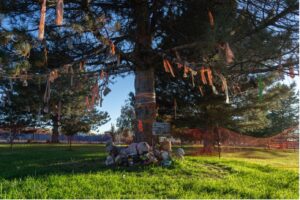
The site of the Albuquerque Indian School cemetery in November 2023
As a researcher in the middle of a dissertation, it is sometimes easy to forget how little others may know about the topic you are studying, especially in my case, as a foreigner studying their country from abroad. During my Fulbright period, I had several opportunities to share stories from my research and tell people living in Albuquerque about a part of the history of their city that they were unfamiliar with. Native American people on the other hand are obviously well aware of this history, as they carry the stories of previous generations and sometimes have stories of their own. Getting to see a bit more of the surrounding area and visiting several of the nearby Pueblo communities also gave me a better understanding of the relationship that existed between these Native American tribes and the government school in Albuquerque. In addition, I had a chance to see some of their dances, as they continue to celebrate their culture and history much like their ancestors. Efforts by the United States government to stop them and other Native American groups from doing so were a failure, and these ceremonies today are a powerful reminder of that fact.
Finally, while this was not my first time in the United States, it was my first encounter with the Southwest and it gave me a new appreciation for the diversity of landscapes, histories and peoples that exist within the country that in Europe we often think of simply as “America.” Looking up at the Sandia mountains that dominate the Albuquerque sky, I could not help but be reminded day in and day out how different the desert landscapes there are to the Dutch countryside where I come from. I also had a chance to see some of the amazing sites in New Mexico like White Sands National Park in the south and Petroglyph National Monument just west of Albuquerque. Culturally, too, it was enriching to be in an environment that is so different from what I am used to, and that differs in significant ways from other places in the United States as well. These include the various Spanish and Mexican influences on local culture, for example in the state’s unique cuisine that includes staples like green chile cheeseburgers and sopapillas, and in the glow of luminarias, the lanterns that line streets and paths at Christmas time alongside the regular lights. Overall, I have come to know Albuquerque as a vibrant place where cultures and languages have clashed and co-existed in an ongoing dance with history.
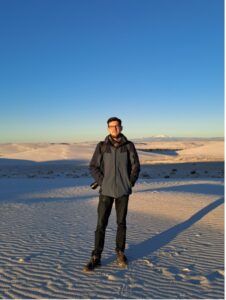
A visit to White Sands National Park
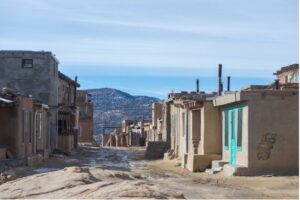
The historical village at Acoma Pueblo, an hour west of Albuquerque

A view of the Sandias from across the Rio Grande
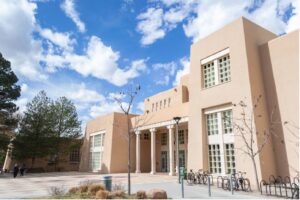
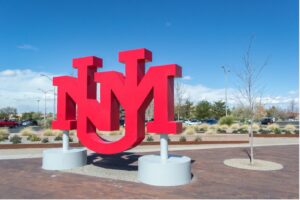
Scenes from the University of New Mexico









